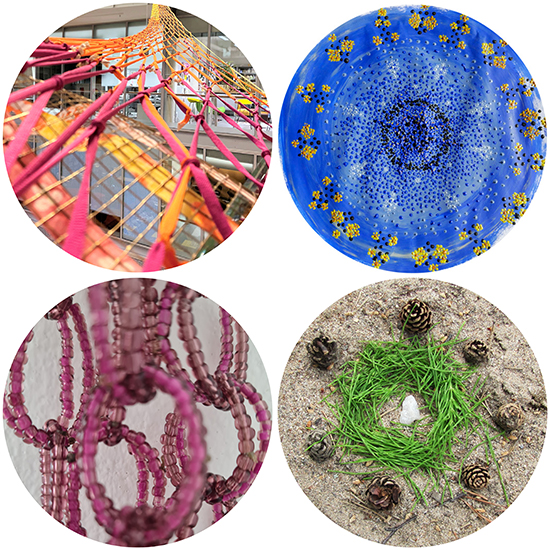Amna Qureshi. Photo: Marko Junttila.
MA Amna Qureshi investigates in her dissertation how frequent engagement with visual literacy can enhance youth’s creative mindsets and provide them with a visual voice that supports their visual competencies. She seeks ways to enhance youth's visual competencies through visual literacy and explores how arts-based methods can aid in grasping the prototype ‘Visual Design Thinking Model’ outlined in her research.
Amna Qureshi argues that encouraging youth to express their feelings and perceptions through arts-based interventions is an essential part of their creative development. She gives evidence that developing visual design thinking competencies helps young people improve their knowledge, skills and attitude under the umbrella term of ‘visual literacy’.
Visual literacy is the ability to interpret, understand, and communicate through visual elements, while visual design thinking is a problem-solving approach that utilises visual elements to ideate, prototype and innovate.
“In the course of one’s educational trajectory, from youth to early adulthood, identity processes are critical, and the need for self-expression can increase. The involvement of visual literacy stimulates students to explore avenues for responsive creative expression and facilitates the growth of their self-confidence as expressive and creative thinkers”, states Qureshi.
Qureshi emphasises comprehending the value of visual literacy, communicating that value and ascertaining whether or not having visual competency can help young people improve their formal and informal learning abilities. She also stresses the importance of teaching youth pluralism and how to reintegrate it into design thinking.
Visual Design Thinking Model
Qureshi introduces the Visual Design Thinking Model as a piece of new knowledge for improving and scaling art-based interventions in art and design education. The knowledge can help shape educational recommendations for the STEAM model, which combines science and the arts through multidisciplinary and participatory approaches.
Qureshi focused on youth aged 19–22 with art and design backgrounds, later extending the scope to include the ages 10–12. She examined the artwork that the study participants had created to verify whether visual literacy had enhanced mental imagery, visualisation, interpretation and problem-solving abilities among the youth employing the Visual Design Thinking Model.

Picture: The images capture the outcomes of various workshops conducted with the participants of the study, showcasing their visual competency and problem-solving abilities.
“To promote young people's visual thinking, it is also important to employ imaginative and artistic techniques to elucidate how they observe, interpret and construct meaning, and they should enhance their reflections in a way that stimulates novel ideas”, says Qureshi.
The results of the research uncovered insights into the topic through a participatory art-based approach, encouraging youths’ creative expressions via their personal artworks.
Information on the public examination
The academic dissertation Visual Voice: Exploring Youths’ Visual Design Thinking through Visual Literacy by Amna Qureshi, MA, is publicly examined in the Faculty of Art and Design at the University of Lapland on Friday 15 December 2023 starting at 2:00 pm (Finnish time) in Esko ja Asko Hall (Yliopistonkatu 8, Rovaniemi).
The opponent is Professor Andrea Kárpáti from Corvinus University of Hungary, and the custos is Professor (Emerita) Kaarina Määttä from the University of Lapland, Finland.
The language of the event is English.
The public defence can be followed online at https://blogi.eoppimispalvelut.fi/ulapland
Information on the doctoral candidate
Amna Qureshi is a visual communication designer and a multimedia artist. She received her education in Visual Communication Design (BA) and Multimedia Arts (MA) from the National College of Arts in Lahore, Pakistan, where she worked as a Lecturer and Assistant Professor of Design for a decade.
Following that, she worked as a doctoral researcher in the European Union’s Horizon 2020–2023 Acting on the Margins: Arts as Social Sculpture (AMASS) research project, the outcomes of which she described in her PhD.
Her research interests include artistic and art & design education experiments. The International Visual Literacy Association (IVLA) in the United States awarded a scholarship in 2023 for her future visual literacy initiatives.
Currently, she is working on a collaborative project at the University of Lapland that is supported by the university's strategic funding: PromoTing Sustainable PRactices for Digitalizing IndigenoUS CulTural Heritage - Global North and South Juxtaposed (TRUST), where she plays a critical role in understanding the ethical digitalisation of Indigenous cultural heritage. She is also a member of the University of Lapland's Bioart tech lab, which works closely with bioart trends to generate opportunities for inspiration, curation of arctic raw materials, collaborative practices and shared authorship in the context of visual design communication.
Further information
Amna Qureshi
Tel. +40 563 7116
first name.surname (at) ulapland.fi
Information on the publication
Amna Qureshi (2023): Visual Voice: Exploring Youths’ Visual Design Thinking through Visual Literacy. Acta electronica Universitatis Lapponiensis 369. ISBN 978-952-337-402-7, ISSN 1796-6310. University of Lapland, Rovaniemi.
Permanent address of the electronic publication: http://urn.fi/URN:ISBN:978-952-337-402-7